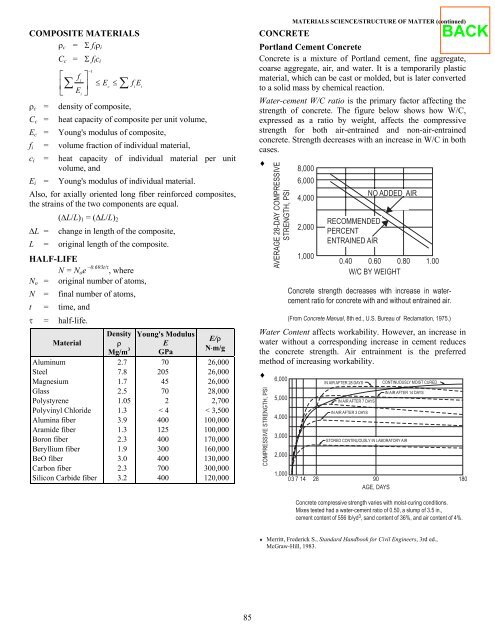fundamentals of engineering supplied-reference handbook - Ventech!
fundamentals of engineering supplied-reference handbook - Ventech!
fundamentals of engineering supplied-reference handbook - Ventech!
You also want an ePaper? Increase the reach of your titles
YUMPU automatically turns print PDFs into web optimized ePapers that Google loves.
COMPOSITE MATERIALS<br />
ρc = Σ fiρi<br />
Cc = Σ fici<br />
⎡ ⎤<br />
⎢ ⎥<br />
⎣ ⎦<br />
−1<br />
fi<br />
∑ ≤ E ≤ f E<br />
c ∑ i i<br />
Ei<br />
ρc = density <strong>of</strong> composite,<br />
Cc = heat capacity <strong>of</strong> composite per unit volume,<br />
Ec = Young's modulus <strong>of</strong> composite,<br />
fi = volume fraction <strong>of</strong> individual material,<br />
ci = heat capacity <strong>of</strong> individual material per unit<br />
volume, and<br />
Ei = Young's modulus <strong>of</strong> individual material.<br />
Also, for axially oriented long fiber reinforced composites,<br />
the strains <strong>of</strong> the two components are equal.<br />
∆L =<br />
(∆L/L)1 = (∆L/L)2<br />
change in length <strong>of</strong> the composite,<br />
L = original length <strong>of</strong> the composite.<br />
HALF-LIFE<br />
N = Noe –0.693t/τ , where<br />
No = original number <strong>of</strong> atoms,<br />
N = final number <strong>of</strong> atoms,<br />
t = time, and<br />
τ = half-life.<br />
Material<br />
Aluminum<br />
Steel<br />
Magnesium<br />
Glass<br />
Polystyrene<br />
Polyvinyl Chloride<br />
Alumina fiber<br />
Aramide fiber<br />
Boron fiber<br />
Beryllium fiber<br />
BeO fiber<br />
Carbon fiber<br />
Silicon Carbide fiber<br />
Density<br />
ρ<br />
Mg/m 3<br />
2.7<br />
7.8<br />
1.7<br />
2.5<br />
1.05<br />
1.3<br />
3.9<br />
1.3<br />
2.3<br />
1.9<br />
3.0<br />
2.3<br />
3.2<br />
Young's Modulus<br />
E<br />
GPa<br />
70<br />
205<br />
45<br />
70<br />
2<br />
< 4<br />
400<br />
125<br />
400<br />
300<br />
400<br />
700<br />
400<br />
E/ρ<br />
N⋅m/g<br />
26,000<br />
26,000<br />
26,000<br />
28,000<br />
2,700<br />
< 3,500<br />
100,000<br />
100,000<br />
170,000<br />
160,000<br />
130,000<br />
300,000<br />
120,000<br />
85<br />
COMPRESSIVE STRENGTH, PSI<br />
AVERAGE 28-DAY COMPRESSIVE<br />
STRENGTH, PSI<br />
6,000<br />
5,000<br />
4,000<br />
3,000<br />
2,000<br />
MATERIALS SCIENCE/STRUCTURE OF MATTER (continued)<br />
CONCRETE<br />
Portland Cement Concrete<br />
Concrete is a mixture <strong>of</strong> Portland cement, fine aggregate,<br />
coarse aggregate, air, and water. It is a temporarily plastic<br />
material, which can be cast or molded, but is later converted<br />
to a solid mass by chemical reaction.<br />
Water-cement W/C ratio is the primary factor affecting the<br />
strength <strong>of</strong> concrete. The figure below shows how W/C,<br />
expressed as a ratio by weight, affects the compressive<br />
strength for both air-entrained and non-air-entrained<br />
concrete. Strength decreases with an increase in W/C in both<br />
cases.<br />
♦<br />
8,000<br />
6,000<br />
NO ADDED AIR<br />
4,000<br />
2,000<br />
1,000<br />
RECOMMENDED<br />
PERCENT<br />
ENTRAINED AIR<br />
0.40 0.60 0.80 1.00<br />
W/C BY WEIGHT<br />
Concrete strength decreases with increase in watercement<br />
ratio for concrete with and without entrained air.<br />
(From Concrete Manual, 8th ed., U.S. Bureau <strong>of</strong> Reclamation, 1975.)<br />
Water Content affects workability. However, an increase in<br />
water without a corresponding increase in cement reduces<br />
the concrete strength. Air entrainment is the preferred<br />
method <strong>of</strong> increasing workability.<br />
♦<br />
IN AIR AFTER 28 DAYS<br />
IN AIR AFTER 7 DAYS<br />
IN AIR AFTER 3 DAYS<br />
IN AIR AFTER 14 DAYS<br />
STORED CONTINUOUSLY IN LABORATORY AIR<br />
CONTINUOUSLY MOIST CURED<br />
1,000<br />
03<br />
7 14 28 90<br />
AGE, DAYS<br />
180<br />
Concrete compressive strength varies with moist-curing conditions.<br />
Mixes tested had a water-cement ratio <strong>of</strong> 0.50, a slump <strong>of</strong> 3.5 in.,<br />
cement content <strong>of</strong> 556 lb/yd 3 , sand content <strong>of</strong> 36%, and air content <strong>of</strong> 4%.<br />
♦ Merritt, Frederick S., Standard Handbook for Civil Engineers, 3rd ed.,<br />
McGraw-Hill, 1983.
















